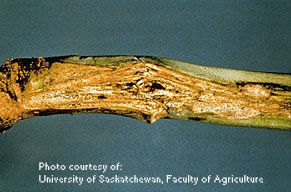Blackleg In Canola
Blackleg is becoming an increasing problem in the Prairies. There is a mild and an aggressive strain. The aggressive strain is now widespread. Losses of over 50% have been recorded in some fields where susceptible varieties of canola were grown.



Host Crops
Canola and rapeseed. Wild mustard is also an important host. Blackleg is not a problem in the highly-resistant mustards (yellow, brown and oriental).
Biology
Blackleg overwinters on infected canola stubble and can survive for at least 2 years. The blackleg fungus may also occur at low levels in the seed. Seed infection is seldom more than 1-2%. However, this amount can introduce the fungus into new areas. The fungus is spread by rain-splashed spores, windborne spores, and by infected seed.
Leaf spots can occur from the seedling stage to maturity. Whitish, round to irregular spots dotted with numerous black fruiting bodies appear on the leaves and stem in the summer. Later in the season, superficial lesions may occur at the stem base. The lesions are coloured white to grey (mild strain) or brown to greyish black (aggressive strain). The brown to greyish black stem lesions become sunken, girdling the stem near the soil line and cause premature death.
Symptoms Of Damage
In the summer, the symptoms are buff-coloured, round to irregular spots with black fruiting bodies. Stem lesions later in the season cause premature plant death.
Do not confuse with premature ripening caused by sclerotinia. Blackleg does not produce sclerotia bodies in the canola stems.
Scouting Techniques
When blackleg spores come in contact with growing canola, they infect the living cells of the plant. Both types of blackleg cause dead patches that appear as pepper-like spots on canola leaves, pods and stems. The aggressive strain infects canola from germination to maturity, while the mild strain is only really active on the ripening crop. Inspect lower leaves for spotting. Check patches in the field where the plants have died prematurely. To distinguish from sclerotinia, look for sclerotia bodies in the stem.
Control Tips
- Disease prevention is important. Use disease-free seed. Seed from diseased areas should be treated with a seed treatment containing a fungicide.
- Resistant varieties of canola are available. The use of moderately susceptible or moderately resistant varieties may still result in low levels of blackleg. Most new Argentine canola varieties are moderately resistant or resistant.
- All Polish varieties are susceptible. Check your provincial seed guide for a listing of the varieties available and their susceptibility to blackleg.
- Incorporate infected stubble after harvest. Blackleg survives in slowly decomposing canola stubble. A 4-year rotation between canola crops is recommended once blackleg has been detected in a field. Control volunteer canola and wild mustard in other crops.

